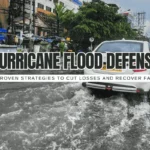Flood losses are stressful enough, but fine print can turn a repair bill into a financial cliff. This guide highlights seven policy clauses that quietly limit payouts, then gives you calculators and checklists to quantify your personal exposure and fix gaps before the next storm.
Basement and Below-Grade Limits
In many policies, items in basements and other below-grade spaces have limited or no coverage. NFIP typically restricts contents and finishes in basements, focusing on essential equipment like the furnace or water heater. Finished walls, flooring, and stored belongings downstairs can be excluded or limited.
- List every finished material below grade. Flag items that are not essential equipment.
- Photograph each wall segment and built-in before storms if possible.
No Additional Living Expense in NFIP
NFIP policies do not cover hotel bills, short-term rentals, meals, or commuting while your home is repaired. Some private policies may offer ALE, but it is not standard. Plan for months of out-of-pocket living costs if the home is uninhabitable.
- Ask your agent in writing whether ALE is included. Keep the email response.
Replacement Cost Eligibility Rules
Replacement cost is often limited to single-family primary residences that meet occupancy and coverage thresholds. Contents are commonly paid at actual cash value, which deducts depreciation. If coverage is below a percentage of replacement cost, you may be paid less than you expect.
- Confirm whether your building coverage qualifies for replacement cost and whether contents are ACV.
Earth Movement and Erosion Exclusions
Damage caused by earth movement like landslide, sinkhole, or erosion is often excluded even when triggered by floodwaters. Foundation cracks caused by soil movement can fall outside the flood coverage scope.
- Ask about add-ons that address ground movement where available.
Mold, Mildew, and Bacteria Limits
Coverage for mold is limited. Insurers expect timely drying and removal of wet materials. Delays, lack of ventilation, or poor mitigation can reduce or void mold-related payouts.
Utilities, Equipment, and Subgrade Components
There are specific lists of covered mechanicals and many exclusions for items like exterior wiring, landscaping, decks, fences, and pools. Subsurface components can be limited. Read the schedule of covered items closely.
Waiting Periods and Lender Issues
Most flood policies have a waiting period, often 30 days, before coverage starts. Lender force-placed policies can be expensive and may not match your needs. Gaps or last-minute purchases can leave you exposed.
Policy Clause Decoder
| Clause | Typical Policy Behavior | What To Ask Your Agent | Mitigation Moves |
|---|---|---|---|
| Basement limits | Finishes and stored contents below grade often limited or excluded | Which basement items are covered and which are not | Move valuables upstairs. Use flood-safe finishes where possible. |
| No ALE | NFIP does not pay living expenses during repairs | Is there any ALE rider or private option | Build an emergency lodging budget. Price short-term rentals in advance. |
| Replacement cost rules | Building may be RC if primary residence and coverage threshold met. Contents often ACV | Do I meet RC conditions. Are contents ACV or RC | Increase limits to reach RC thresholds. Keep receipts and photos. |
| Earth movement | Landslide, erosion, and similar often excluded | Any endorsements for soil movement | Improve drainage and grading. Avoid heavy loads near foundations. |
| Mold limits | Strict mitigation expectations and dollar caps common | How are mold costs handled and capped | Dry within 24–48 hours. Keep a mitigation log with timestamps. |
| Utilities & subgrade | Equipment list is specific. Many exterior items excluded | What mechanicals are covered. Any subgrade limits | Raise equipment where feasible. Add sump with backup power. |
| Waiting period | Coverage usually starts after a set waiting period | Exact waiting period and exceptions | Bind policies well before season. Avoid coverage gaps. |
Shortfall Calculator
Estimate your likely out-of-pocket exposure if a first-floor and basement flood occurs. This is a planning tool, not a claim estimator.
Your Exposure
Improve this number by raising contents to main floor, adding private policy ALE, or switching finishes below grade.
Proof Checklist for Smoother Claims
Open checklist
- Ask your agent to confirm in writing: ALE status, basement limits, contents ACV vs RC, waiting period.
- Inventory contents with photos, serials, and purchase dates. Store offsite or in cloud.
- Photograph mechanicals and keep invoices for recent upgrades.
- Move high-value items out of below-grade spaces before storm season.
- Plan for temporary housing. Identify two local options and price them now.
- Set a calendar reminder for renewal 60 days early to review limits and riders.
Design Moves That Avoid Gaps
Flood-smart finishes
Use tile or sealed concrete below grade. Choose removable baseboards and flood vents where code allows.
Raise equipment
Elevate water heater, HVAC, and laundry. Consider quick-disconnects and check valves to reduce losses.
Plan power and pumps
Add a sump with battery backup. Keep a generator or inverter ready for dehumidifiers and fans.



